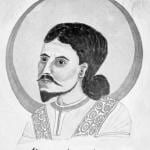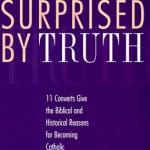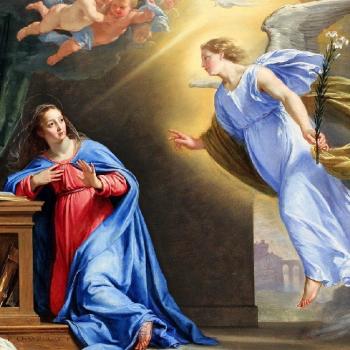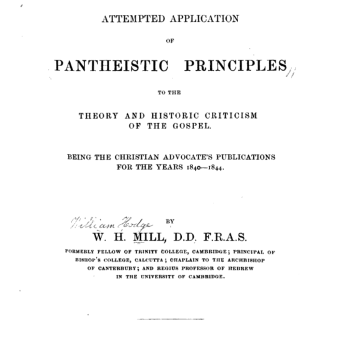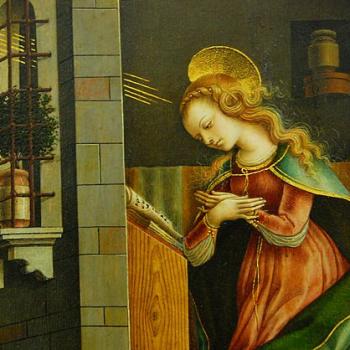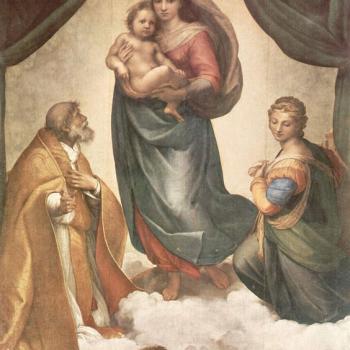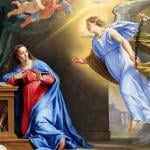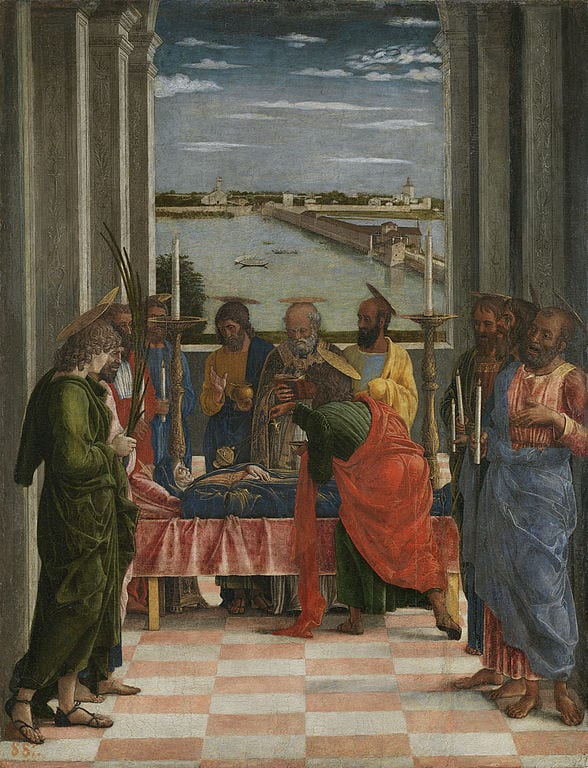
Reformed Protestant anti-Catholic polemicist James Swan wrote a truly ludicrous and clueless article on Bishop James White’s blog, entitled, “On the Death of Mary: Why the Infallible Interpreter Still Needs to be Interpreted” (10-16-11). His words will be in blue.
*****
As I’ve understood Roman Catholicism, it isn’t determined one way or the other that Mary died. A Roman Catholic is free to believe either.
It’s one of the many marvels of Swan’s polemics, that he actually starts out with the truth, and then proceeds to contradict himself as he continues along. He should have stopped with these two sentences. But then it wouldn’t be much of an article, would it?
Catholic Answers founder Karl Keating states,
The Church has never formally defined whether she died or not, and the integrity of the doctrine of the Assumption would not be impaired if she did not die, but the almost universal consensus is that she did in fact die [Karl Keating, Catholicism and Fundamentalism (San Francisco: Ignatius Press, 1988), p. 273].
Yep.
Against this “almost universal consensus” is none other than Patrick Madrid. Of Revelation 12:1-8 he states,
This passage also shows us a vision of Mary, queen of heaven, and hints at her Assumption. The gift of suffering no corruption in the grave and of being ‘caught up’ into heaven while still alive is perfectly in accordance with Scripture [Patrick Madrid, Where is That in the Bible? (Indiana: Our Sunday Visitor, 2001), pp. 71-72].
Well, “almost universal consensus” means that there are those who disagree (a minority “dissenting party” so to speak); so this is an instance of that, which is perfectly acceptable and permissible within a Catholic framework. So why does Swan consider it noteworthy?: is the question. If the claim was that no Catholic at all (i.e., among scholars, theologians, bishops, apologists, catechists, etc.) thought Mary didn’t die, then he would have something notable: a Catholic self-contradiction.
The Catholic Church has different levels of authority (even — believe it or not — different levels of infallible authority, as I have written about, way back in 1999). There are things that are obligatory beliefs, and binding on all Catholics. “Mary was assumed bodily into heaven” is one of these. It’s a dogma at the highest level. “Mary died” and “Mary didn’t die” — on the other hand — are tenets concerning which Catholics are fully allowed to speculate and disagree. Another example of undefined beliefs of this sort would be different views concerning predestination (usually the discussion is characterized as “Thomism vs. Molinism.”
Now, there is an essential difference (but no logical contradiction) between the following two things:
1) Catholics are allowed to disagree on Issue x in theology.
2) Catholics in fact fall into two camps as regards Issue x: one believes a and another (much smaller) believes in b, as concerns x.
#1 is a determination of Catholic authority or the magisterium, which determines and establishes the limits and parameters of Catholic dogmatic and doctrinal beliefs (i.e., it is prescriptive). The magisterium can either require a particular belief to be held by Catholics, or decide that the issue is sufficiently uncertain, so as to allow (and even encourage) honest differences of opinion among equally pious and honest and sincere Catholics.
#2 is a sociological statement of what Catholics as a whole (now and throughout history) believe and have believed (i.e., it is descriptive).
It’s a scenario of “apples vs. oranges.” But — oddly enough — James Swan seems to think that there is some sort of contradiction and hypocrisy in this area, and makes it the very heart of what he is contending in this article (complete with a flat-out dumb, non sequitur title). He’s dead wrong (which is, sadly, not an infrequent occurrence with him, when dealing with Catholicism and Catholics). It’s no contradiction or “scandal” or “embarrassment” that Catholics in fact disagree (to some extent: in this case, a fairly small extent) on a question where they are fully permitted by their Church to disagree. That’s not news at all. It’s a complete yawner and “ho hum.”
Now, it so happens, as Karl Keating noted in Swan’s citation of him, the belief that Mary died among Catholics, is overwhelming, in terms of relative beliefs. But it’s not absolutely unanimous; nor is it required belief (thus, Patrick Madrid is completely within his “rights” as a Catholic to believe as he does, which makes Swan bringing him up, in an attempted “gotcha!” salvo, an irrelevant curiosity).
It may be that in due course, with more development and theological speculation, that the Church declares authoritatively that Mary died (personally, I hope that she does). If this occurs, then observant Catholics would no longer be able to assert / speculate that she did not die.
Against this “almost universal consensus” is also the New Catholic Answer Bible:
If indeed she was free from sin, then it follows that she would not have to undergo the decay of death, which was the penalty for sin [The New Catholic Answer Bible (Kansas: Fireside Catholic Publishing, 2005) Insert F2].
Now, here is where the “fun” really begins, because I am the author of this insert. I wrote it originally in The Catholic Answer Bible, and then it was slightly edited by co-author of the inserts, Dr. Paul Thigpen, for the expanded New Catholic Answer Bible (twice as many inserts). The sentence above is identical in the two versions, save for an added “have to” in the newer version.
Swan has misquoted me, because I did not assert either way, whether Mary died or not. What I wrote was that “she would not have to undergo the decay of death“: a notion which is perfectly consistent with her having died or not died. If she didn’t die and went straight to heaven, her body obviously wouldn’t decay. But if she died, then God would instantly take her to heaven bodily, in which case she also didn’t experience the decay of death. I am not against the overwhelming consensus. I agree with it. I personally believe that God would allow Mary to die so as to be more like her Son (Who also died but did not undergo decay). But if the Church eventually declared that she didn’t die, I would gladly submit to that.
In Ven. Pope Pius XII’s proclamation of the Bodily Assumption of Mary (1 November 1950), allusion is made to this:
4. That privilege has shone forth in new radiance since our predecessor of immortal memory, Pius IX, solemnly proclaimed the dogma of the loving Mother of God’s Immaculate Conception. These two privileges are most closely bound to one another. Christ overcame sin and death by his own death, and one who through Baptism has been born again in a supernatural way has conquered sin and death through the same Christ. Yet, according to the general rule, God does not will to grant to the just the full effect of the victory over death until the end of time has come. And so it is that the bodies of even the just are corrupted after death, and only on the last day will they be joined, each to its own glorious soul.
5. Now God has willed that the Blessed Virgin Mary should be exempted from this general rule. She, by an entirely unique privilege, completely overcame sin by her Immaculate Conception, and as a result she was not subject to the law of remaining in the corruption of the grave, and she did not have to wait until the end of time for the redemption of her body.
When Pius XII specifically proclaimed and defined the dogma (section 44) he used the language of “having completed the course of her earthly life”: which is consistent with either her having died or not died (like Elijah and Enoch and those who are saved and alive when Christ returns). But he also alluded to her death no less than twelve times in the same document, as Fr. Ryan Erlenbush has pointed out.
I made my own view clear in my book, A Biblical Defense of Catholicism (completed in 1996, self-published in 2001 and published by Sophia Institute Press in 2003). I cited in agreement, St. John Henry Cardinal Newman (Sermon for the Assumption, 1849):
She died, then, as we hold, because even our Lord and Savior died . . . She died . . . not . . . because of sin. but to submit herself to her condition, to glorify God, to do what her Son did. (p. 192)
I can assure all that I did not change my mind between 1996 and 2002, when I wrote the insert in question for The Catholic Answer Bible. Nor have I since. In fact, the chapter on Mary was completed by 10 April 1993, according to my notes, and only slightly modified to include citations form the Catechism of the Catholic Church.
On the other hand, there are Roman Catholic web pages like this stating the following:
In any case, it is at least a sententia certa (a certain teaching) that our Lady died before being raised and assumed into heaven. This is the clear and explicit tradition of the West and is maintained in a slightly less-clear (and more metaphorical) manner also in the East.
Ludwig Ott, in his Fundamentals of Catholic Dogma (revised version published in 2018, edited by Dr. Robert Fastiggi, a good friend of mine), classified the statement, “Mary suffered a temporal death” (p. 224) as “Common teaching . . . a doctrine which in itself belongs to the field of free opinions, but which is generally accepted by theologians” (p. 11). Thus, the website Swan cited, was slightly inaccurate as to its dogmatic status: being relatively more sure than what expert on doctrinal classifications, Dr. Ott concluded.
The confusion stems from the magisterial teaching of Pope Pius XII in Munificentissimus Deus. Some say he did not explicitly state that Mary died. Some Roman Catholics read this “infallible” pronouncement and state:
This certitude that Mary in fact died and was believed by the Roman Catholic Church to have died before her bodily assumption is nicely addressed by Pope Pius XII when he states in section 17 of Munificantissimu Deus… in quoting an historical source that “Adrian I, our predecessor of immortal memory, sent to the Emperor Charlemagne. These words are found in this volume: ‘Venerable to us, O Lord, is the festivity of this day on which the holy Mother of God suffered temporal death, but still could not be kept down by the bonds of death, who has begotten your Son our Lord incarnate from herself.”
There is no “confusion” as to whether Ven. Pope Pius XII defined the question of whether Mary died or not. He did not define that (at the highest dogmatic level) in the section with the de fide proclamation (44). No informed Catholic that I’m aware of (including the above quotation) disagrees with that. We simply have some remaining disagreement as to whether she died. Again, that’s not “confusion.” Rather, it’s permitted difference of opinion due to this point not being defined at the highest levels (which would mean that disagreement would have to cease). I grant that there are some subtleties and nuances here, but I don’t think it’s rocket science, and I believe that Swan is capable of grasping it (if only his anti-Catholic blindness and bigotry didn’t prevent him).
It’s far less of a difference than, say, the difference between James Swan believing in infant baptism, and his hero James White (Reformed Baptist) believing in adult believer’s baptism and being emphatic that it is not a sacrament. That’s a major difference indeed: so major that Martin Luther and John Calvin both believed that Anabaptists (who believed in adult baptism) were to be drowned as seditious, heretical radicals (i.e., Luther and Calvin would have approved of James White being executed by drowning; just for the record, I would not).
In our topic under consideration, the fact of death or a miraculous lack of death is not even of the essence of the belief, which is (agreed upon by all Catholics and Orthodox): 1) bodily assumption to heaven, and 2) lack of any bodily decay, whether or not she died. But Swan and White (very typically of Protestant divisions throughout history) can’t even agree on whether baptism 1) regenerates (Luther said yes, Calvin and Swan say ???, White says no), 2) whether it is a sacrament (Luther and Calvin and Swan say yes, White, no), and 3) when to perform it (Luther and Calvin and Swan say as an infant, unless, of course, it is an adult convert, White says only as a believing adult or one past the age of reason).
Other Roman Catholics reading the same document declare:
However, the definition infallibly declared by Pius XII does not explicitly state that the Blessed Virgin suffered death: “We pronounce, declare, and define it to be a divinely revealed dogma: that the Immaculate Mother of God, the ever Virgin Mary, having completed the course of her earthly life, was assumed body and soul into heavenly glory.”
Again, Pope Pius XII does not define that she died or didn’t die when he formally proclaimed the dogma in one section (44). But (as I already mentioned), he does allude to her death (i.e., the overwhelming majority Catholic view) in other places, of lesser dogmatic authority. This is much ado about nothing. These previous two quotations do not contradict each other anymore than the earlier ones do. Swan simply engages in very sloppy logical thinking, and labors under illusions and seemingly ignorant misconceptions as to how Catholic authority functions.
These interpretive snippets demonstrate an ironic flaw in Romanism: even their alleged infallible dogmatic pronouncements are open to interpretation.
Some may be somewhat unclear (where Catholics disagree a bit), but in this case, it is not. No one disagrees. But I doubt that Swan can be made to see this, because he isn’t willing to 1) think logically, and 2) be intellectually fair to Catholic positions and explanations. I’ve shown how he definitely misrepresented my opinion on the matter. He is doing the same with Pope Pius XII, and simply exhibiting his own ignorance.
We need to continually remind Roman Catholics about this when they argue that they have some sort of superior certainty that non-Romanists do not. Roman Catholics sometimes say that if one lacks an infallible interpreter, one is left with private interpretation (as Patrick Madrid call it, “a blueprint for anarchy”). But what this often assumes is that the actual infallible pronouncements don’t need to be interpreted… but they do! One never escapes private interpretation, so when Roman Catholics raise the issue, the double standard needs to be exposed. One may respond that it really isn’t that important whether Mary died or not. That individual Roman Catholics quibble over it is no big deal. Actually though it’s simply one more example of a much bigger problem. For instance, on the fundamental issue of what are, or are not, the very Words of God, Catholics are not unified.
This is silly and frivolous argumentation: what has been called “the infallibility regress”. I’ve refuted it many times:
Dialogue on the Logic of Catholic Infallible Authority [6-4-96]
Church Authority & Certainty (The “Infallibility Regress”) [July 2000; some revisions on 12-8-11]
Dialogue on the Protestant “Non-Quest” for Certainty [3-15-06]
Ecclesiological Certainty (?) & the “Infallibility Regress” [5-22-03 and 10-7-08]
Glorying in Uncertainty in Modern Protestantism (Dialogue with a Calvinist) [11-11-09]
Does Church Infallibility Require Infallible Catholics? [6-8-10]
Radically Unbiblical Protestant “Quest for Uncertainty” [2-12-14]
***
Related Reading:
Assumption & Immaculate Conception: Part of Apostolic Tradition (vs. James White) [June 1996]
Mary’s Assumption: Dialogue w Evangelical Protestant [1-21-02]
Bodily Assumption of Mary: Harmonious with the Bible? [2002]
Mary’s Assumption: Brief Explanation, with a New (?) Biblical Parallel [3-1-07]
Mary’s Assumption vs. Material Sufficiency of Scripture? [4-22-07]
Mary’s Assumption & “Reformer” Heinrich Bullinger [4-6-08]
Mary’s Assumption & Historic Protestantism [6-30-08]
Immaculate Conception and Assumption: Why Defined So Late? [2-1-09]
Mary’s Bodily Assumption: Eleven Related Bible Passages [2009]
Defending Mary (Revelation 12 & Her Assumption) [5-28-12]
Is Mary’s Assumption Able to be Inferred from Scripture Alone? [8-14-15]
Bible on Mary’s Assumption [2015]
***


